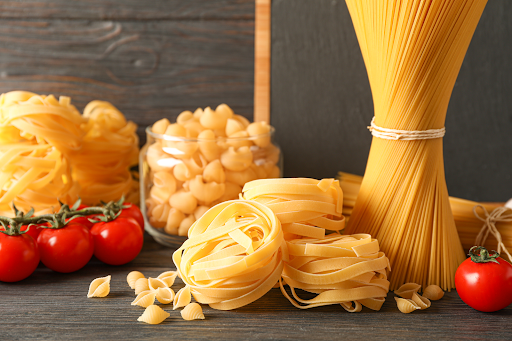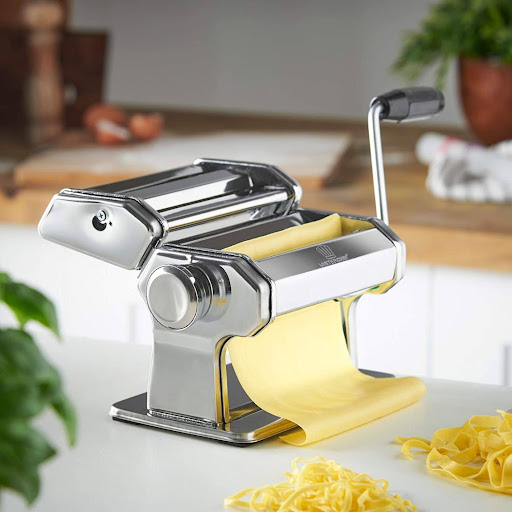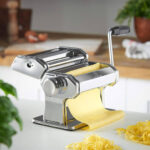Store-bought pasta comes with detailed instructions, from the type of pans to use, the amount of water needed, the ideal water temperature, to the exact cooking time for perfect results. But if you’ve rolled out your own dough, things can get a bit tricky. One thing is for sure, you cannot follow the same instructions as your store-bought pasta. This is because unlike store-bought pasta, which is made with water, homemade pasta usually contains eggs, giving it a higher moisture content.
So, how long should you cook fresh pasta for? And how can you tell if it’s done? Let’s find out below.
What’s the Difference Between Store Bought and Fresh Pasta?

The main difference between the two is their ingredients and texture. Store-bought pasta or dried pasta is typically made from just water and durum wheat semolina, making it firmer and requiring a longer cooking time. It’s designed to have a longer shelf life, which is why it’s sold dry.
On the other hand, fresh pasta usually includes all-purpose flour and eggs, giving it a denser texture and a higher moisture content.
How Long Does Fresh Pasta Take to Cook?
Due to the higher moisture content, homemade pasta cooks faster. Typically, it takes 2 to 4 minutes unlike store-bought pasta, which can take up to 12 minutes. The exact time depends on the thickness of your pasta. Thinner shapes, like angel hair, might need only a couple of minutes, while thicker ones, like fettuccine or filled pasta shapes like ravioli, could take a bit longer.
How to Make Fresh Pasta Dough
Making fresh pasta dough at home is easy and only requires a few basic ingredients:
Ingredients:
- 2 cups of all-purpose flour (plus extra for dusting)
- 3 large eggs
- A pinch of salt
Steps:
- Start by cleaning your countertop thoroughly. Then, pile your flour on the surface, creating a hollow in the center. This well will hold your eggs, so make sure it’s large enough.
- Crack the eggs into the center of the hollow. Add your pinch of salt to the eggs.
- With a fork, gently beat the eggs, slowly blending in the flour from the edges of the well. Continue mixing with the fork until the egg mixture becomes thick and starts to come together.
- Once the dough starts forming, use your hands to bring it together into a ball. Knead the dough by pressing it with the heels of your hands, folding it over, and turning it. Continue this process for about 8-10 minutes until the dough is smooth and elastic.
- Form the dough into a ball and cover it with plastic wrap. Allow it to rest at room temperature for at least 30 minutes.
How to Roll Pasta Using a Pasta Machine

Once you’ve let your pasta dough rest for at least 30 minutes at room temperature, follow these steps to roll it:
- Secure your pasta machine to a sturdy table or countertop. Start with the rollers at the widest setting, usually marked as ‘0’ or ‘1’ on the machine.
- Cut your rested dough into 4 pieces to make it easier to work with.
- Take a piece of dough and press it down with your hands or a rolling pin until it’s thin enough to pass through the widest setting of your pasta machine.
- Pass the dough through the rollers. Gently guide it with one hand while turning the crank with the other.
- After the first pass, fold the dough in half, and pass it again. Do this folding process 2-3 times.
- Adjust the machine to the next narrower setting. Pass the dough through once. There’s no need to fold it anymore.
- Keep rolling the dough through narrower settings until you reach the desired thickness. For most pasta, a medium-thin setting is ideal (usually around setting ‘4’ or ‘5’ on most machines).
- Once you have your pasta sheets, you can use them as is for lasagna or cut them into strands or shapes.
Can You Use Fresh Pasta Right Away?
Absolutely. But most professional chefs suggest letting it dry overnight. This helps the dough stiffen, making it easier to handle when you cook or roll it. If you’re in a rush, go ahead and use it immediately. Otherwise, place it on a drying rack or baking sheet and use it the next day.
If you’re not using it right away, after drying your pasta, transfer it to an airtight container and store it in the fridge. It can last up to 2 weeks like this.
How to Cook Fresh Pasta
Here’s a breakdown of how to cook pasta that you’ve freshly made:
Step 1: Bring Water to a Rolling Boil
Start by filling a large pot with plenty of water – use at least 4 quarts of water for every pound of pasta. This gives the pasta ample space to move and cook evenly. Heat the water over high heat until it reaches a vigorous, rolling boil.
Step 2: Add Salt
Once your water is boiling, add a good amount of salt. A general guideline is to use about 2 tablespoons of salt for every pound of pasta. Since your pasta is going to be in the water for a minimal amount of time, it’s important to be generous.
Step 3: Gently Add the Pasta
Carefully lower your fresh egg pasta into the boiling water. If it’s long strands, like spaghetti or linguine, hold the ends and slowly swirl them into the water, letting them fan out and soften gradually to avoid sticking.
Step 4: Stir Gently
Give the pasta a gentle stir or two with a wooden spoon or pasta fork. Stir just a few times during the boiling process.
Step 5: Check for Doneness
After letting the pasta cook for around 2 minutes, take out a piece to taste. While store-bought pasta should be cooked al dente, fresh pasta should be cooked until it feels smooth and silky without any hardness or bits sticking to your teeth. If it’s not quite ready after 2 minutes, keep checking it every 30 seconds. Depending on the shape of the pasta, this process might take up to 4 minutes. If you’re cooking filled pastas like ravioli, it might take even longer.
Step 6: Drain the Pasta
Once your pasta is cooked, drain it in a colander. If you’re not serving it immediately, toss it with a little olive oil to prevent it from sticking. Remember to keep some of the pasta water aside for your sauce.
Summary
Cooking fresh pasta is easy when you know the right techniques and timing. With these guidelines, you’ll become a pro at cooking perfect fresh pasta every time. And for even more convenience, consider trying out MisterChef, the ultimate pasta maker that simplifies pasta preparation like never before. Shop with us today.






